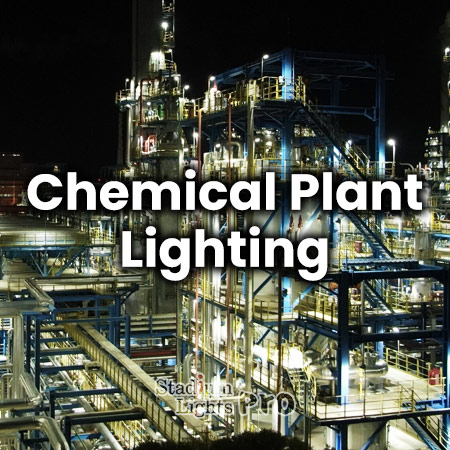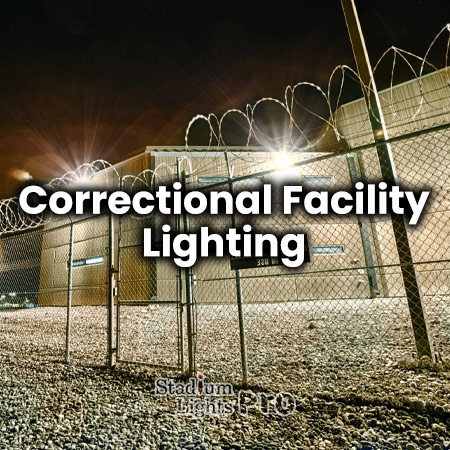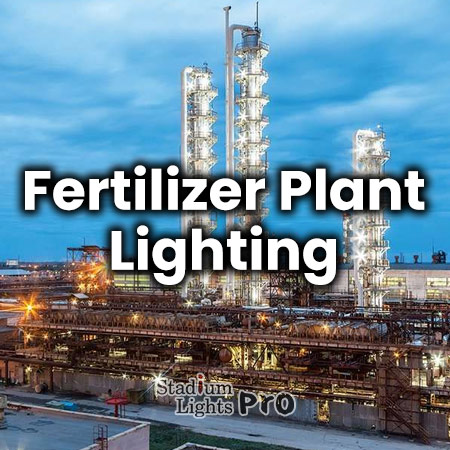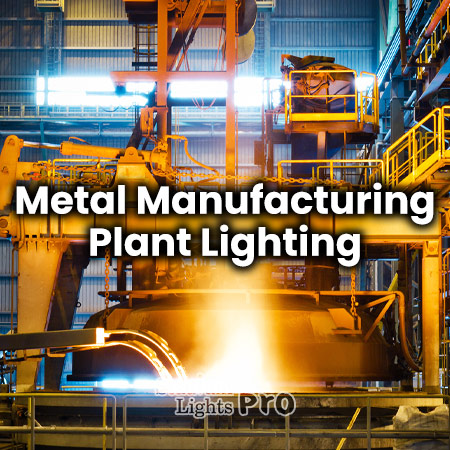Chemical plants play a critical role in manufacturing products that are essential to modern life, from pharmaceuticals and plastics to petrochemicals and fertilizers. Within these complex and often hazardous environments, proper lighting is crucial for both safety and operational efficiency. We will explore the importance of lighting in chemical plants, the unique challenges it poses, and the innovative solutions that have emerged to address these issues.
The importance of lighting in chemical plants
Safety
Safety is paramount in chemical plants where workers deal with hazardous materials and intricate machinery. Inadequate lighting can lead to accidents, injuries, and even fatalities. Proper illumination helps operators identify potential hazards, read gauges, and respond quickly to emergencies.
Product quality
Accurate visual inspections are vital to ensuring product quality and preventing defects. Proper lighting allows workers to spot imperfections, contaminants, and irregularities in chemical processes, thereby reducing waste and ensuring that products meet strict quality standards.
Energy efficiency
Effective lighting can significantly impact energy consumption in chemical plants. Implementing energy-efficient lighting technologies reduces electricity costs and minimizes the plant’s environmental footprint, contributing to sustainability efforts.
Challenges in chemical plant lighting
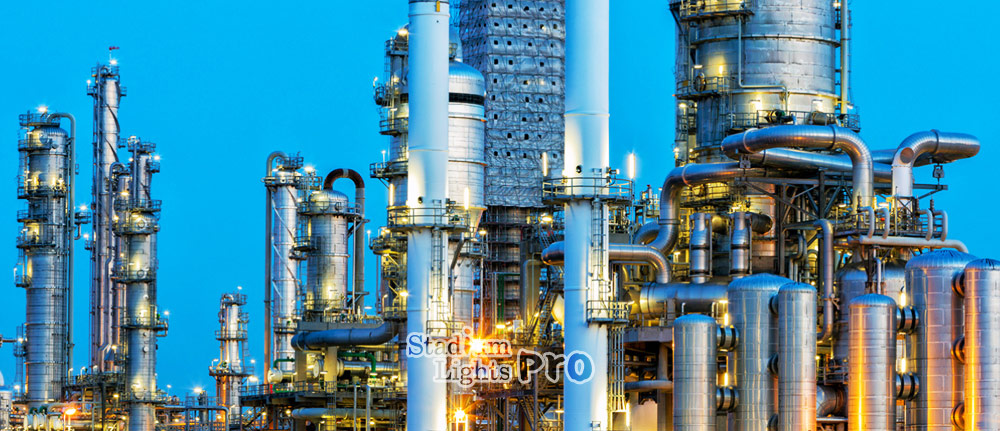
Hazardous environments
Chemical plants are inherently hazardous environments due to the presence of flammable or explosive materials.
Safety concerns
Safety is of paramount importance in chemical plants. The use of conventional lighting fixtures in such environments can lead to sparks or overheating, potentially causing explosions or fires. Therefore, specialized lighting solutions designed to meet safety standards and regulations are imperative.
Dust and gas classifications
Lighting fixtures must be selected based on the dust or gas classifications within the plant, as different hazardous materials require specific protection methods. For instance, the National Electrical Code (NEC) classifies hazardous areas into divisions and zones, each requiring different levels of protection.
Corrosive substances
Exposure to corrosive chemicals can degrade lighting fixtures over time, leading to increased maintenance costs and potential safety hazards. Resistant materials and proper sealing are essential to mitigate this issue.
Degradation and maintenance costs
Exposure to corrosive substances can gradually deteriorate lighting fixtures over time, leading to increased maintenance costs. This corrosion not only affects the aesthetic quality of fixtures but can compromise their structural integrity and electrical components, potentially resulting in safety hazards.
Resistant materials
To mitigate corrosion-related issues, lighting fixtures in chemical plants must be constructed using materials that are highly resistant to chemical corrosion. Materials such as stainless steel, epoxy-coated aluminum, or corrosion-resistant polymers are commonly used to ensure fixture longevity.
Proper sealing and enclosures
Sealing and enclosures are crucial to prevent corrosive substances from infiltrating lighting fixtures. Gaskets, seals, and enclosures should be designed to provide a tight barrier, protecting the internal components from exposure.
Varying lighting needs
Chemical plants typically consist of different areas with varying lighting requirements. For example, control rooms may need uniform, high-intensity lighting, while storage areas may require lower-level illumination. Adaptable lighting systems are crucial to meet these diverse needs efficiently.
Control rooms
Control rooms necessitate uniform, high-intensity lighting to ensure operators can accurately read instrument panels and respond swiftly to critical situations. Properly lit control rooms are essential for process monitoring and safety.
Storage areas
Storage areas, on the other hand, typically require lower-level illumination for tasks like inventory management and equipment storage. High-intensity lighting in these areas may not be energy-efficient or necessary.
Adaptable lighting systems
To efficiently meet the diverse lighting needs across different areas of a chemical plant, adaptable lighting systems are crucial. These systems may include dimmable fixtures, occupancy sensors, and zoning controls, allowing for tailored lighting levels based on the specific tasks and safety requirements of each area.
Best chemical plant lighting design
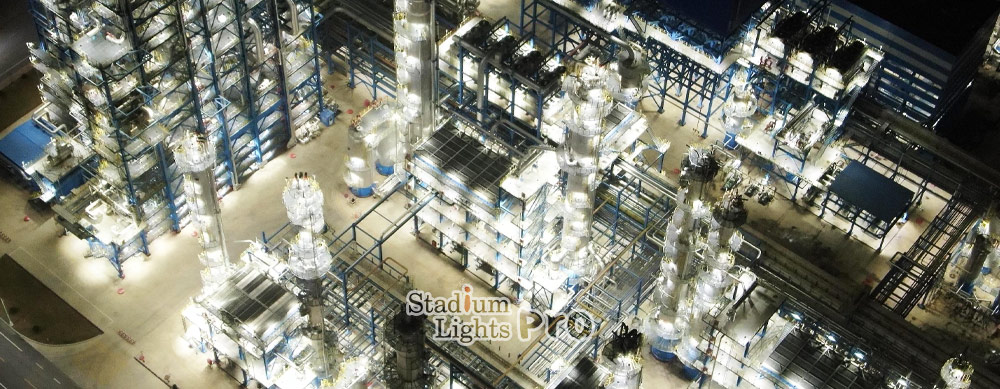
Achieving the best lighting design for chemical plants involves careful consideration of various factors, including illuminance levels (lux), uniformity, Color Rendering Index (CRI), and color temperature. Here’s a step-by-step guide to help you achieve an optimal lighting design.
Understand the specific needs of different areas
Start by categorizing different areas within the chemical plant. Common areas may include control rooms, process areas, storage areas, walkways, and emergency exit routes.
Understand the tasks performed in each area. Some areas may require high-intensity lighting for detailed work, while others may need lower-level lighting for general navigation.
Determine illuminance levels (Lux)
Refer to international lighting standards such as the Illuminating Engineering Society of North America (IESNA) guidelines or local regulations to determine recommended lux levels for different areas in chemical plants.
Consider the specific tasks performed in each area to determine whether the recommended lux levels need to be adjusted. Critical tasks may require higher illumination levels.
Indoor chemical plant lighting lux recommendation
Control rooms and laboratories
- General Illumination: 300 – 500 lux
- Critical tasks (e.g., reading gauges and instrument panels): 750 – 1000 lux or higher
Maintenance areas and workshops
- General illumination: 300 – 750 lux
- Detailed work (e.g., equipment maintenance): 750 – 1000 lux or higher
Storage areas
- General Illumination: 150 – 300 lux
Outdoor chemical plant lighting lux recommendation
Walkways and pathways
General illumination: 20 – 50 lux
Loading docks
- General Illumination: 150 – 300 lux
- Specific tasks (e.g., checking incoming shipments): 500 – 750 lux
Parking lots and perimeter
- General Illumination: 10 – 20 lux (lower levels may be acceptable for perimeter lighting)
Emergency exit routes
- General Illumination: 10 lux (minimum during emergencies)
Outdoor storage areas
- General Illumination: 50 – 150 lux
Ensure uniformity
Strive for uniform lighting to minimize glare, shadows, and contrast, which can lead to eye strain and reduced visibility. Uniformity ratios (minimum-to-average illuminance) should typically be as close to 1 as possible.
Properly position luminaires to achieve even light distribution. Consider the height and spacing of fixtures to achieve uniformity across the area.
Select the right Color Rendering Index (CRI)
CRI measures how accurately colors are rendered under a light source compared to natural sunlight. In chemical plants, accurate color perception is crucial for safety and quality control.
Choose lighting fixtures with a high CRI (typically 80 or higher) to ensure that workers can accurately identify colors of labels, safety signs, and materials.
Choose appropriate color temperature
Different areas may benefit from varying color temperatures. For example, cooler color temperatures (5000K or higher) may be suitable for task-oriented areas where visual acuity is critical, while warmer color temperatures (3000K-4000K) can be used in administrative or break areas for a more relaxed atmosphere.
Ensure that the selected color temperature does not negatively impact CRI. High-CRI LEDs are available in various color temperatures to provide both quality color rendering and the desired ambiance.
Chemical plant lighting cost
The cost of lighting a chemical plant can vary significantly depending on several factors, including the size of the facility, the type of lighting technology used, the specific lighting requirements, and local energy rates. As a broad estimate, the cost can range from tens of thousands to several hundred thousand dollars or more. Retrofitting an existing facility with energy-efficient LED lighting may have a lower upfront cost compared to designing and installing a lighting system in a new plant, which can involve higher initial expenses for fixtures, wiring, and controls.
Furthermore, ongoing maintenance and energy consumption costs should be factored in for a comprehensive understanding of the long-term expenses associated with lighting in a chemical plant. A thorough lighting design and cost analysis conducted by lighting professionals would provide a more precise estimate tailored to the unique needs of the facility.
What lights are used in chemical plant?
Explosion-proof fixtures
Explosion-proof lighting fixtures are specially designed to operate safely in hazardous environments. These fixtures are sealed to prevent the entry of explosive gases or dust and are constructed from materials that can withstand chemical exposure.
LED technology
Light Emitting Diodes (LEDs) have revolutionized the lighting industry due to their energy efficiency, long lifespan, and adaptability. LED lighting is particularly well-suited for chemical plants, as it provides bright, consistent illumination while reducing energy consumption.
Zone lighting
Implementing zone lighting allows chemical plants to tailor illumination levels to specific areas, optimizing energy use and ensuring that each space receives the appropriate amount of light for its intended purpose.
Emergency lighting
Given the potential for power outages or equipment failures, chemical plants must have reliable emergency lighting systems in place. These systems ensure that workers can safely exit the facility during emergencies.
Remote monitoring
Some modern lighting systems are equipped with remote monitoring capabilities, allowing plant operators to check the status of lighting fixtures, monitor energy consumption, and identify maintenance needs, all from a centralized control center.
Can we use LED lights in chemical plant?
Yes, LED (Light Emitting Diode) lights are a suitable and increasingly popular choice for lighting in chemical plants. LED lighting offers several advantages that make it well-suited for these industrial environments.
Energy efficiency
LED lights are highly energy-efficient, consuming significantly less electricity compared to traditional lighting technologies such as incandescent or fluorescent lights. This reduced energy consumption can lead to substantial cost savings over time.
Longevity
LED fixtures have a much longer lifespan than conventional lights, often lasting tens of thousands of hours. This extended lifespan reduces maintenance and replacement costs, which can be especially beneficial in hard-to-reach or hazardous areas within chemical plants.
Durability
LEDs are solid-state lighting devices, meaning they have no fragile components like filaments or tubes that can break or shatter. They are more resistant to shock and vibration, making them suitable for industrial settings.
Instant on
LED lights turn on instantly to full brightness without the warm-up time required for some other lighting technologies. This feature ensures immediate visibility and eliminates delays in critical areas.
Temperature tolerance
LEDs can operate efficiently in a wide range of temperatures, making them suitable for both indoor and outdoor applications within chemical plants.
Customizable lighting
LEDs can be easily dimmed and controlled, allowing for precise adjustments to match the specific lighting requirements of different areas within the plant.
Color rendering
High-quality LED fixtures can provide excellent color rendering, making it easier for workers to distinguish between colors and identify hazards or defects accurately.
Reduced heat emission
LEDs emit very little heat compared to traditional lighting sources. In chemical plants, where temperature control is essential, this characteristic can contribute to a more comfortable working environment and potentially lower cooling costs.
Reduced environmental impact
LED lighting is environmentally friendly due to its energy efficiency and reduced maintenance needs. It produces fewer greenhouse gas emissions, making it a sustainable choice.
Compatibility with controls
LEDs work well with lighting control systems, allowing for dynamic adjustments in response to changing operational needs or occupancy levels.
When implementing LED lighting in chemical plants, it’s crucial to consider the specific requirements and potential hazards of the environment. For hazardous areas, explosion-proof LED fixtures should be used to ensure safety compliance. Besides, the selection of LED fixtures with appropriate ingress protection (IP) ratings and resistance to corrosive substances is essential for long-term performance.
Conclusion
Proper lighting in chemical plants is not just a matter of aesthetics; it is a critical component of safety, product quality, and operational efficiency. As technology advances, chemical plant operators have more tools at their disposal to address the unique challenges posed by these environments. With the right lighting solutions, chemical plants can enhance safety, reduce operational costs, and contribute to a more sustainable future while ensuring that the vital products they produce continue to meet stringent quality standards.
For expert guidance and a complimentary consultation on designing the ideal lighting system for your chemical plant, don’t hesitate to get in touch with us. Our team of professionals is ready to provide you with a tailored, energy-efficient lighting solution that enhances safety, productivity, and cost-effectiveness. Contact us today to schedule a free consultation and take the first step towards optimizing your chemical plant’s lighting infrastructure.

